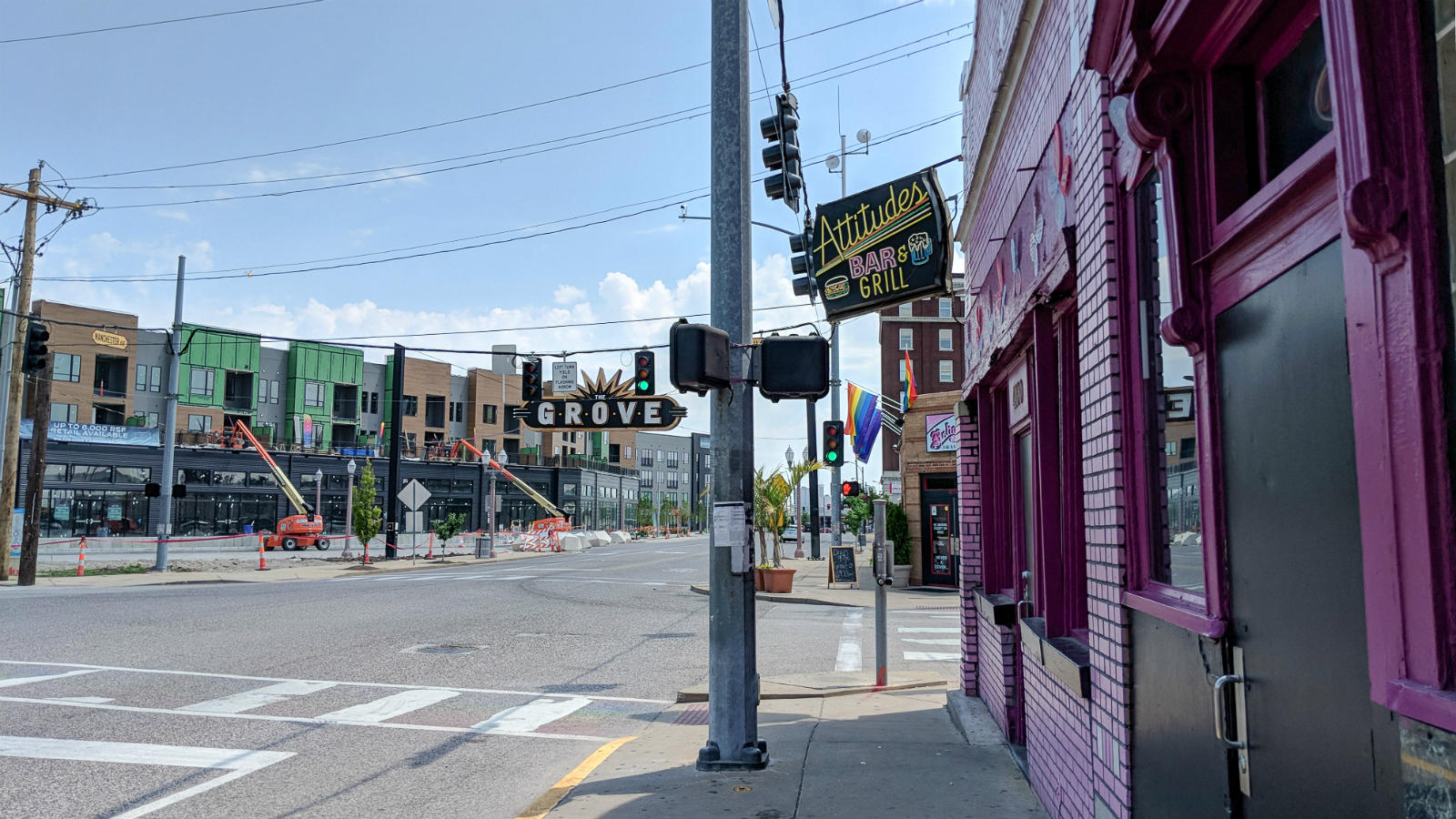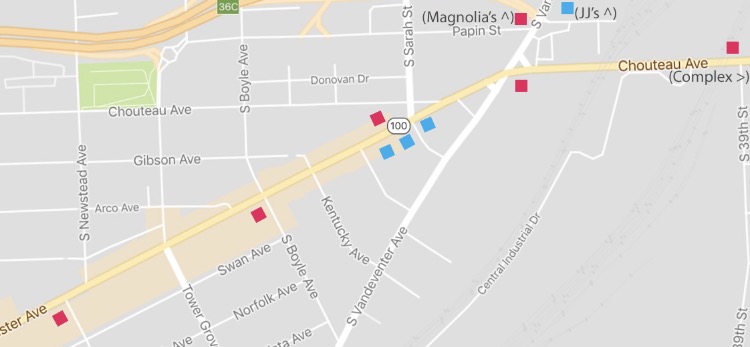It’s nine o’clock on a Saturday and Rehab, the prominent Grove patio bar has its door propped for boys who like to be first. A neon marquee twitches above the entry, and a pulsing beat welcomes gays to their first stop of the night. For years, this edgy strip of bars has been a hub for the LGBT community, but that was eight years ago—back when gay bars were the only thing in The Grove. Now, the night is shared by the echoes of other bars—straight ones—that symbolize change in the neighborhood. While the music from the gay bars is still loud and proud, it feels the scene is closing in. Rents are up, and The Grove is hot. As growing pains fizzle and The Grove seizes its hipster identity, will gay be included in the narrative?
It seems that once an area flips, the LGBT scene dies. The transition of gay nightlife is often not questioned, but the placement of gay bars plays a huge part in determining what developers call “the next-it-neighborhood.” To understand the future of that transition, people have to understand the dynamic of LGBT development.
The Gayborhood
Similar to those who’ve settled in St. Louis before, gays seek harmony within their own neighborhood. Existing in a community where one can be recognized for their character rather than sexual identity is a dream. Just as The Hill promotes itself as the Italian neighborhood in St. Louis, gays want to have their own gayborhood. Sadly, support for the community hasn’t always been there—within and without—meaning the existence of gay anything has always been scattered and hidden. Where gay people go and settle in St. Louis can often be determined by the nightlife scene.
There will always be the gay bar—a place to get drinks and talk to people who share mutual friends and interests. It is a profitable endeavor for those who know how to put on a show, though they aren’t always successful. Owning a gay bar is high maintenance, and many come unprepared.
With a customer base the size of a small suburb, a bar can be extremely difficult to run. Especially since most who go into the gay bar business have minimal experience. Dubbed the “bartender-come-bar-owner trend,” these individuals often rise to the occasion to save existing spaces. People say they like the idea of being enveloped within the community as a reason for opening. Of those are owners of Bar: Pm, Chad and James who say, “We wanted to give back to our LGBT community by offering another place for people to come and be themselves.”
Historically, gay entrepreneurs have moved to dead ends of the city—formerly the West End and now the Grove– citing affordability and isolation as reasons to stake their claim. These two factors prove crucial for the survival of gay nightlife: affordability enables profit, while isolation eliminates judgment. The once broken stretch of Manchester offered owners affordability in an isolated, urban location. Community favorites such as Novak’s and Attitudes thrived here for years. Attitudes, the pink building, has been there for over thirty years.
LGBT businesses can be considered some kind of rainbow for breathing life into delicate neighborhoods. And though that isn’t necessarily their intention, others see their energy as a fire starter. Former bar owner Mark Erney was one of the first to spearhead opportunity in the FPSE neighborhood when he opened Erney’s. He says what once was a dribble of gay bars became a haven for hipsters. “Once other clubs and businesses move in, it always seems to take away what the gays considered their safe haven. It doesn’t necessarily want to make them leave; it just feels like it’s no longer special,” he explains. “And as new development raises property costs, as most bars are leased spaces, it becomes tougher to turn a profit.”
The problem is that many bar owners don’t own their building—they lease. So when leasing becomes a headache and expenses limit profit, owners turn to sale. The sale then brings a new identity to vacancy, and gay bar owners move on. The cycle then repeats itself, bringing a new corner of disinvestment to the forefront.
Shown is a map of closures and remaining gay bars. Bars in red are closed.
(From left to right: Meyer’s Grove, Erney’s 32, Novak’s, Just John’s, Attitudes, Rehab, and Bad Dog).
Changing Times
Some say gay nightlife is phasing out. Online publications cite social media and apps like Grindr that will deter men from pursuing their usual watering hole. Others fear the common “acceptance” factor will diminish the need for “gay” anything.
However, 2018 acceptance may be a myth. Basel Isa, a South City native, says, “What makes me go to gay bars is the freedom that comes with it. Yes, the eye candy is nice, but at the end of the day, it’s great being in a space where I can be myself. Straight bars may seem open, but it feels like the judgment is silent. Or worse, it feels like we’re ‘entertainment’ for straight people.”
What’s lacking are places that make The Grove more gay: Speakeasies, cafes –non-alcoholic options are truant. That factor could be blamed on the city’s size, but what’s interesting is that these places do exist—they’re just not centrally located. Many thrive in pieces of what-used-to-be, including the CWE and Tower Grove neighborhoods. If the Grove were to market itself as a gay destination, establishments like H&M, Starbucks, and Andrew Christian would be at home here.
Fragmentation
Perhaps it’s not a problem of attendance, but fragmentation. The gay scene reflects bad regionalism in St. Louis. Though there are many factors working against its success, it’s often working against itself. Those who go out describe gay nightlife as cliquey and uninviting. Although many feel more welcome than in straight bars, they don’t always feel welcomed by other gays. Clubgoers often weigh drama and controversy as reasons to or not to choose a bar. Beef with the owner or clientele can kill business. Social media and gossip determine the flow from bar to bar.
Same goes for the St. Louis region. Instead of working together to attract business as St. Louis, the county competes with the city. Suburbs are more aggressive to bleed St. Louis than they are Kansas City, Cincinnati, and other peers. Similarly, gay bars want to be the only party. Those who go to Rehab may refer to Just John’s as family, but won’t associate with Attitudes. The whole atmosphere becomes less about healthy competition and more about boycotting business and taking sides.
Many roadblocks face the LGBT community in St. Louis. Whether these are external or internal forces that kill the gay nightlife scene should be fronted. In the region, we investigate the cause and effect of white flight. We analyze interstate expansion costs; we talk about de-urbanization and blight, but we’ve never talked LGBT. It’s time to look at where gays have been and where they are going. The Grove is going a lot of places, but gay isn’t one of them.


